Corn from 2023 harvest was stored on the cob at 72°F until February 10 2024 and there was in total 57lbs of shelled Hopi Blue Corn suitable for planting. We have 3 strains of corn from 2023 including Hopi Blue, Hopi White (1lb), Hopi Pink (2 lbs), as well as some crosses. Of this about 20% is from Field 1 and 80% from Field 2 with another 10lbs of immature corn from Field 2. The Hopi Blue ears varied in color from almost black to pale blue depending on the maturity. Corn was sorted into batches based on strain, kernel color variations, cob size/quality, plant color, and kernel maturity to test germination rates. Germination was greater than 95% for all batches except the lightest Hopi Blue tested where the germination was 75%. The Hopi Pink produced more with fewer plants than the Hopi White but kernel color, plant size, and plant appearance were very similar. We have also collected additional Hopi Pink, Hopi White, and other varieties for testing.
Batch List 2023
- Hopi Pink - White with pink tinge (normal pink)
- Hopi Pink - White (no noticeable pink)
- Hopi Pink - Strong Pink to Dark Red
- Hopi White - White with varying degrees of pink tinge (normal white)
- Hopi White - White (no noticeable pink)
- Hopi Blue - Blue (batches sorted by field origin and shade/maturity)
- Hopi Blue - Mixed Colors (cobs peppered white/blue or kernels mottled grey/maroon)
- Hopi Blue - Reddish Stalks or Reddish Husks (these stayed green longer in Field 1)
- Hopi Blue - Red Plant (the whole plant was maroon red)
- Hopi Pink/Blue Hybrid - Pollinated by Hopi Blue
- Hopi White/Blue Hybrid - Pollinated by Hopi Blue
A small percentage of the Hopi Blue (not crossed) had ears with a grey rust chinmark color pattern and others were speckled with pure white kernels. Hopi Blue color darkens with maturity and the image in middle shows a cob with light immature kernels that probably will not germinate. In right image below the middle cob is darker and has a deep maroon shade while the two on the left are dark blue with a white cob. This difference is not very noticeable in the image but clear enough to the naked eye and the stalks and leaves of this maroon corn display varying degrees of red. One plant from Field 1 was completely dark maroon red including the ear. stalk, and leaves.

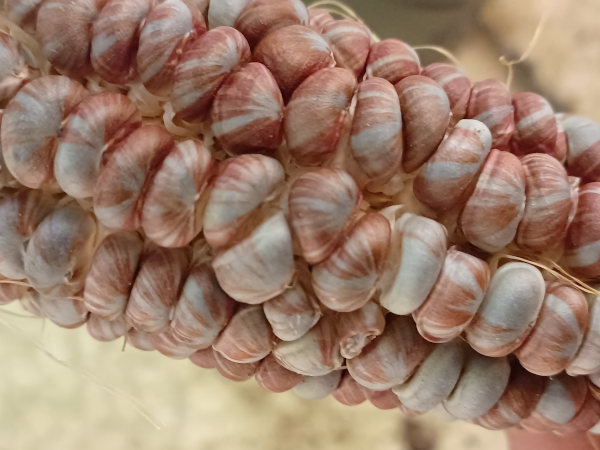
2023 Harvest / Hopi Blue Chinmark Earthtone
|
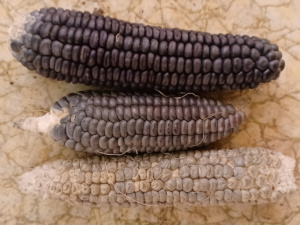
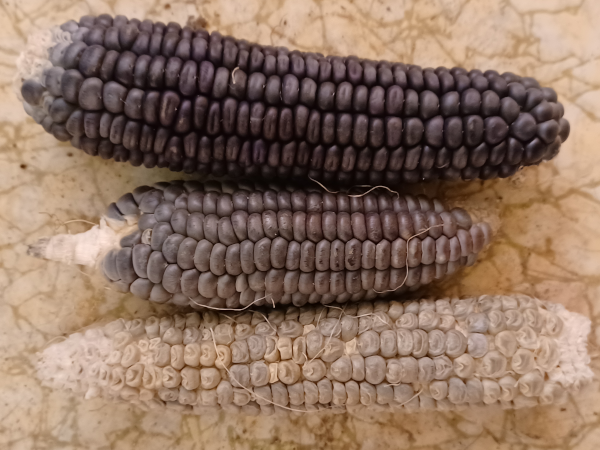
Hopi Blue / Maturity Affects Color
|

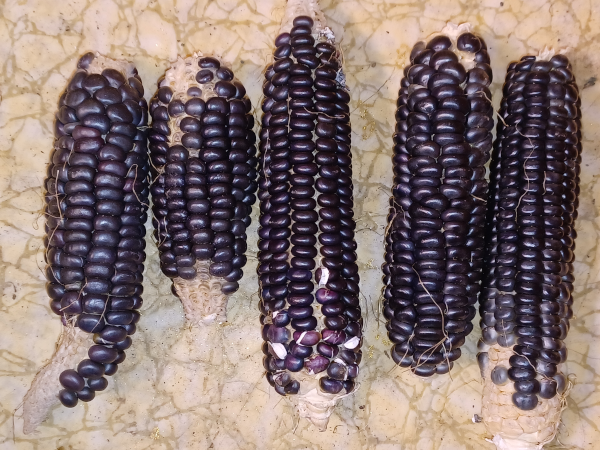
Hopi Blue / Color Variation
|
Fertilizer
In contrast to 2023, fertilizer was applied to all fields and tilled in at recommended levels (120lbs N/acre, 80lbs P2O5/acre, 100lbs K2O/acre, plus some micronutrients).
Sorghum
We planted 6 types of sorghum by pre-sprouting, drilling 3-6 inch holes, placing seed, and backfilling with 2 inches of soil but none emerged. Sorghum seeds are much smaller with fewer energy reserves compared to corn and with dry top soil the seedlings probably die before they can reach moisture or conversely if planted deeply are unable to reach the soil surface.
Sorghum (Update Aug 26 2024)
One of the plants near the Hopi Pink area where Gaolian Voskovidnyj sorghum was planted has 5 sorghum seed heads. The first head doesn't have many kernels (temperatures too high for pollination) but the second head which developed during recent cooler weather is forming plump green sorghum kernels. The other heads are developing well.
Seed Preparation / Pre-Sprouting
Prolonged soaking of fresh corn seeds, more than 12 hours, can cause in a lack of oxygen resulting in poor germination and seeds which are too far along in the germination process have emerging roots and easily damaged by handling. Old seeds may benefit from multiple soak/rest cycles but fresh seeds from the previous year only need an 8-12 hours soak at room temperature. After soaking, seeds should be drained and can be kept another 8-12 hours at room temperature, after which roots should begin to emerge. If there is enough seeds, floating seeds should be discarded. Some floaters will sprout but not discarding them can result in spotty emergence and an uneven field. Alternatively plant twice as many as needed and thin later. Sometimes seeds are soaked but planting the next day is not possible due to weather (wind) and we found that putting soaked seeds in the refrigerator delays germination and may also damage the seeds. In the Hopi Blue field, the first 8 rows sprouted followed by rows 15-23 followed last by rows 9-14 which had been planted earlier but refrigerated.
Our refrigerator is set very low (near freezing but not frozen) and refrigeration of seeds reduced seedling vigor. The first day we planted rows 1-4 and had left over seed that was refrigerated. The first part of row 5 was planted with the refrigerated seed and there is a clear difference in the plants at the first part of the row and the rest of the row(s) planted the same day. It would be better to store extra soaked corn seeds just below 50°F since this will pause germination but reduce the damage to the seeds caused by near freezing temperatures.
Daily Planting Schedule / The Work
Seeds were soaked overnight, drained in the morning, and kept at room temperature before leaving for work. After returning water was again added to the seeds followed by trenching, planting, and covering. It took 3-4½ hours to plant 4-6 rows 630 feet long sometimes with 1 person helping to place the seed. If drilling we usually did 600 holes at a time where I'd drill the holes while my son placed the seed and filled. The drill starts getting hot after about 400 seeds and needs to be left to cool or switched with another drill. It is better to place the seeds immediately to know which holes have been done and reduce the chance of the hole filling/caving in before seed placement. We drilled and planted the Concha White (500 seeds) in less two hours including watering and covering and were bringing the tools and hoses back from the field at the 2-hour mark. Except for Kikam Hu:n which was put in an irrigated bed, Concha White was the only variety we watered during planting. Drilling is not a comfortable endeavor especially if you have back problems but my personal experience is the exercise reduced my recurring lower back pain (not during the work but later). DISCLAIMER: This is not medical advice and I do not advocate anyone to do this as treatment, just my personal experience so far. When using an augur to drill holes, seedlings in partially backfilled holes do poorly and it is better to backfill holes completely.
Using a tractor with a middle buster to make a trench 12" deep and hand seeding is easier. Presprouting took precedence over using a precision row seeder given the dry conditions. The soil in the trench was too clumpy to roll the seeder and the presprouted seeds were damaged and stuck together. We tried using a length of ½ inch pipe to place the seeds but it was too time-consuming for little gain. We drop the seeds in the trench in a zig-zag pattern and also with a few in the center of the trench. They bounce around and some end up in the wrong spot or the same spot as others and we don't stop to fix those but "just keep swimming - just keep swimming". It is best to trench/drill, place seed, and backfill in one session because the open trench/hole and exposed seeds will start to lose moisture and exposed seeds are vulnerable to animals. If planting in a trench, after seeding, more make more than one pass with the rebar harrow and put the tines down for at least one pass to get adequate seed coverage. Optionally, run over the tops of the furrows with cultipacker to further firm the soil and reduce lodging.
Planting Method Notes
Though drilling holes with an augur is more labor intensive than the middle buster trench planting method, I was surprised at how fast I was able to plant using the augur and very impressed with the results using the augur, soil is firmer, plants are more stable, and soil evaporation is reduced.
Planting in a zig-zag pattern results in better space utilization and faster canopy closure but it makes it more difficult to backfill/hill around the corn later. Plants are off center are more easily damaged during hilling operations. Ideally it would be better to get a planter that plants 2 or 3 rows at once, then use coultiers to backfill at planting time. The current method we use is limited since the middle buster can only do a single row every tractor width which is 4 feet apart at best, and a double mold board plow might be a better option.
Updated Planting Times Notes
The season here changes too quickly in the spring to beat the summer heat. Planting in late April delayed emergence due to cool soil temperatures and tassel formation started in the beginning of July when temperatures were hitting 109°F even for the earliest corn varieties. Future experiments should focus on varieties and planting methods that improve heat and drought tolerance or practices that improve retention of soil moisture rather than focusing on early planting or early maturation. Early planted corn gets the brunt of summer heat at pollination time and late planted corn doesn't dry down enough before first frost.
Varieties In Order Of Planting 2024
- Wikti (Hopi Greasy Head / Planted Late April)
- Smoik Hu:n (Pima 60 Day type / Planted Late April)
- Hopi White (2023 + new / Planted Early May)
- Hopi Pink (2023 + new / Planted Early May)
- Ki:kam Hu:n (Pima 60 Day type with 80% soft flour 20% flint / Planted Late May)
- Hopi Blue (2023 + new / Planted Late May - Early June)
- Concha White (Planted June 9th 2024)
Wikti Hopi Corn (600) seeds were soaked and planted in east-west rows in an area that partially overlapped 2023 Field 1. One half of the seeds were planted using a 1' middle buster at maximum depth resulting in a trench 8-12 inches deep and placed seeds evenly in the bottom of the trench followed by dragging a rebar harrow upside down to cover them with 3-8 inches of soil. The tractor is more than 4 feet wide so driving on the high part between the trenches and overlapping the tire creates rows 3-5 feet apart. The second half of the seeds were then planted between the trenches on the high parts using a drill and 2" garden augur 6-10 inches deep in a rough zig-zag pattern resulting in a double row 1' apart and 1' between plants in each row. This closer planting should result in earlier canopy closure, shading from sunlight, and reduced evaporation. Soil was partially or fully replaced and while emergence was similar plant health seemed to get more moisture and do better when the soil was completely replaced (holes backfilled).
The probability of freeze is usually past by May 15th but there was an early hot summer-like period followed by several nights in May that dipped below freezing much later than usual until May 30th. Temperatures on site in spring are typically at least 5° colder than reported by the weather station ½ a mile away at the same elevation on the same "flats" and a prediction of 38°F or colder indicates a possibility of freeze (with observed frost on the squash leaves followed by damage). We had another freeze on June 16th, go figure. About half of the the corn sprouted and had damaged outer leaves but survived and is growing well. In this patch, there was better emergence with the trench-planted seeds. Wikti is an earth-tone flour corn and one of the first types of corn to mature. These plants are shorter than Hopi White and Hopi Pink and they produce many tillers and a single seed resulting in a clump of stalks.

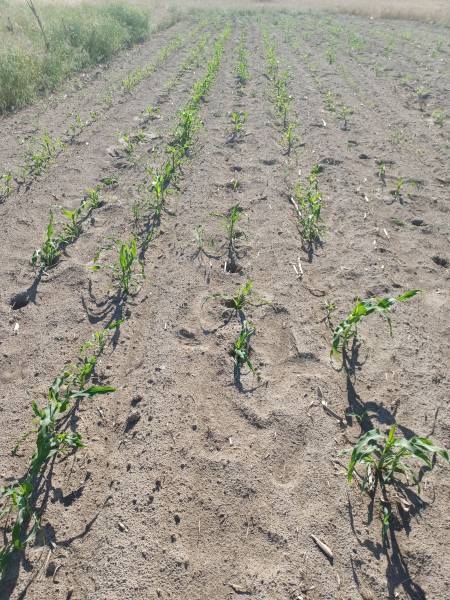
Wikti Corn / Hopi Greasy Head
|


Wikti Corn / Hopi Greasy Head
|
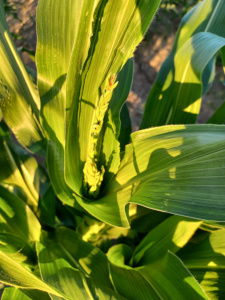

Wikti Corn / Tasseling Jul 9th
|
Wikti (July 9th Update)
Wikti was planted earlier but is shorter than Smoik Hu:n and Hopi White, is the first to show drought stress, and some plants are tasselling. Canopy cover in some areas is about 60%. Plants planted by row show more drought stress than those planted using the augur drill method and those that weren't fully backfilled show more water stress than the fully backfilled augur holes. This planting overlaps a part of 2023 Field 1 that generally did poorly in that year but the overlap area was the slightly better area of Field 1. The Wikti was planted as early as possible but emerged slowly because the soil was still cold and now with daily high temperatures over 100°F is just beginning to tassel.
It may be better to select plants that can survive the heat and lack of water than to try and beat the heat by early timing. Last year Field 2, which was planted later than Field 1, did better than Field 1 despite some of the ears not being mature enough to save seeds. It also seems Field 2 generally has more accessible underground moisture than Field 1. A later crop could be a workable solution as once seed reserves were sufficient some could be saved each year to replenish seed stocks and the less mature ears used for human and livestock consumption.
Wikti (August 20 Update)
I will get some seed from this field but this is the second year I have had poor results in this area. The positive is that the harvested seeds will have undergone 1 year of selection to be better able to thrive and produce in absence of irrigation.
Smoik Hu:n (Tohono O'odham 60 Day Corn)
Hopi Smoik Hu:n (1200) seeds were soaked and planted in north-south rows with an augur 300 feet west of the Wikti (2023 Field 1). The soil was dry on top but a few inches down there was sufficient moisture for germination. Parts of this field was planted in straight rows and part was planted using the zig-zag pattern to make double rows explained above. Emergence was very poor but a few of the emergent corn are bigger than the Wikti which was planted earlier. This type of corn makes tillers early and seedlings in partially backfilled holes did not perform as well as seedlings in fully backfilled holes. Smoik Hu:n is one of the earliest maturing types of white flour corn that can be harvested at the milk stage or used to make tortillas after dry. These plants make many tillers and a single seed results in a clump.
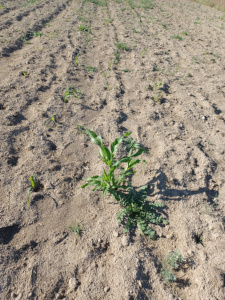
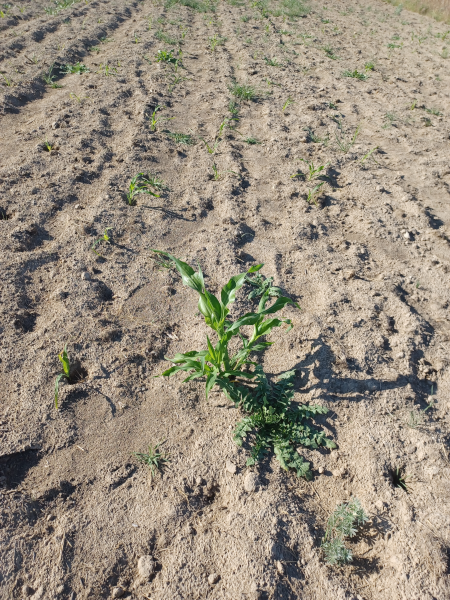
Smoik Hu:n Corn / Not Ideal
|
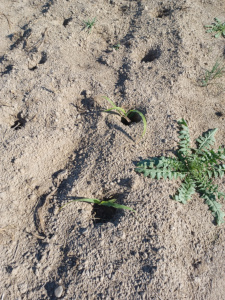

Smoik Hu:n Corn / Not Ideal
|
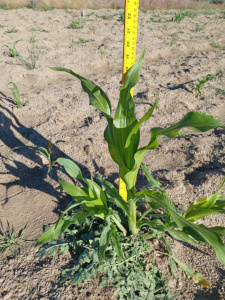
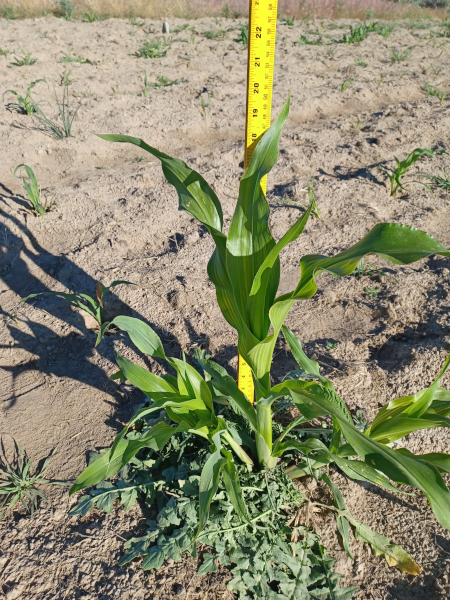
Smoik Hu:n Corn / Fast Growing / Weeds 4 Mulch
|
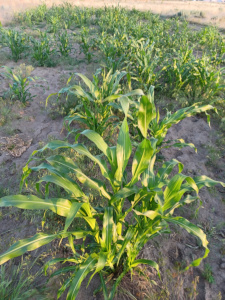
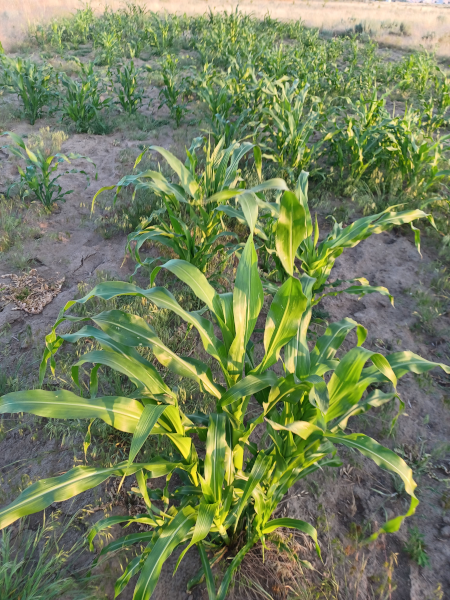
Smoik Hu:n Corn / Tasseling Jul 9th
|


Smoik Hu:n Jul 9 vs Blue Jul 25 2023
|
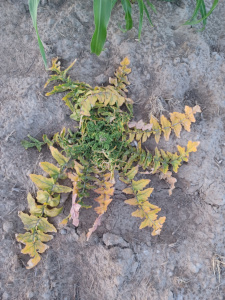
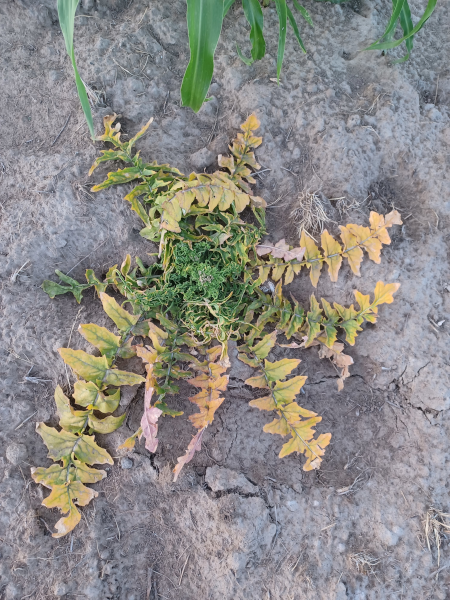
Smoik Hu:n Jul 9 / Dying Tumble Mustard
Seed emergence was very poor for this batch. The quality of newly purchased seed is usually lower than for saved seeds and if possible it's better grow-out a smaller batch and save the seeds to plant a larger field the next year. Some of these plants were damaged by frost on June 16th. The field is dry enough that the immature tumble mustard are dying while the corn looks good. The best of the Smoik Hu:n grew the faster and are taller than the Wikti, are tasseling, and nacent ear sheath leaves are emerging from axils (ear formation has begun). Smoik Hu:n are similar maturing but slightly taller than the Hopi White which was planted a little later. This is the earliest initial ear formation observed so far compared to initial ear formation for Hopi Blue in 2023 which was 16 days later. The 2023 Hopi Blue was also planted later than the Smoik Hu:n this year so it is difficult to compare "earliness" without side by side testing. For certain the Smoik Hu:n and Hopi White from this year are ahead of the Hopi Blue from 2023 by aproximately 15 days. I may have incorrectly been focusing on earliness to increase yield. Under local conditions slower maturation (combined with other characteristics like stay green) might be desirable if it improves the final yield and conversely selecting for earliness specifically isn't desirable unless it increases the yield of mature kernels.
Smoik Hu:n (August 20 Update)
This is another very poor location and coupled with poor emergence very little seed will be harvested.
Hopi White
Hopi White from 2023 plus new Hopi White (1700 seeds) were combined, soaked, and planted by trench method and with an augur 300 feet south and 300 feet west of the Smoik Hu:n field. This is (2023 Field 2) where we previously grew Hopi White/Pink/Blue and soil moisture was acceptable. Several planting methods were tried including with an augur 6-10 inches deep, with augur drilled holes at the bottom of a filled trench (deep planting), with augur at the bottom of an un-filled trench, and with seeds placed at the bottom of a rebar harrow filled trench. Emergence was varied but in contrast to other strains Hopi White emergence was better with augur "only" but emergence was also good in some trench "only" rows. Combined augur drilled holes at the bottom of a "filled" trench with seeds being very (8-16 inches) deep resulted in extremely poor emergence (seeds were planted individually one per hole). It is possible that planting multiple seeds per hole would compensate for poor emergence when seeds are planted deeply. Hopi White is pink-tinged white flour corn with plants being short, 3-5' high, that is normally planted deeply in clumps with 6-10 seeds per hole and then thinned to 3-6 plants per group (hill method). These plants make many tillers and a single seed results in a clump.
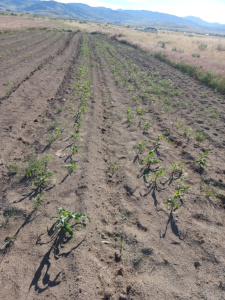
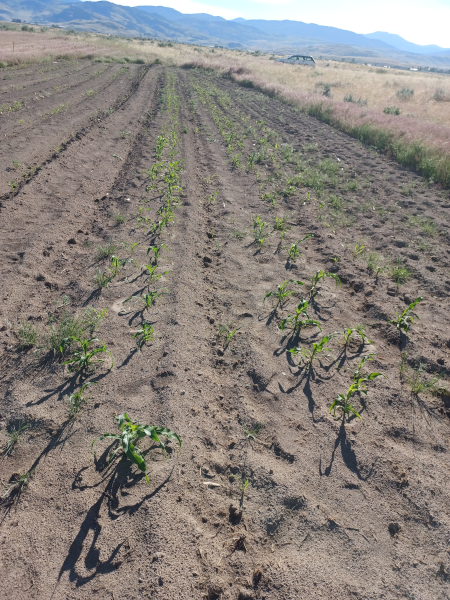
Hopi White Corn
|
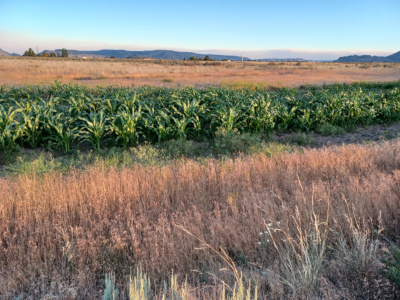
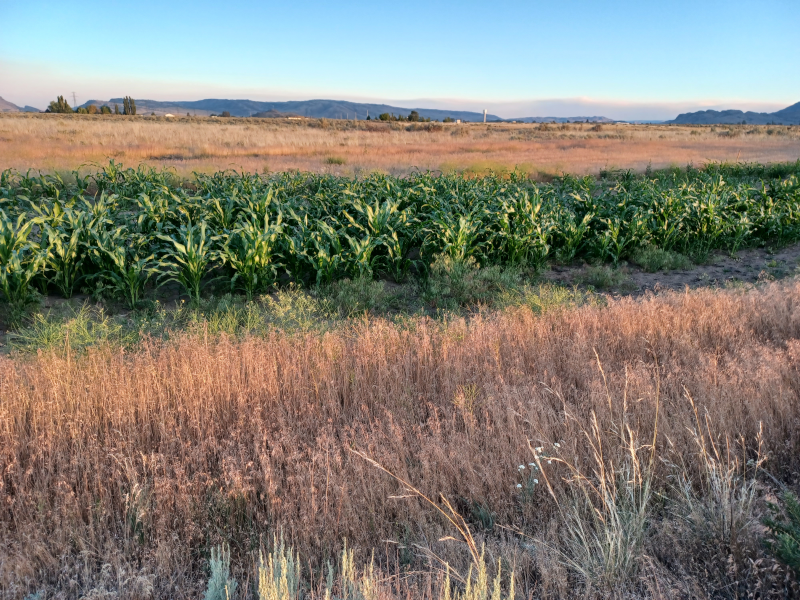
Hopi White Corn / Tasseling Jul 9th
|
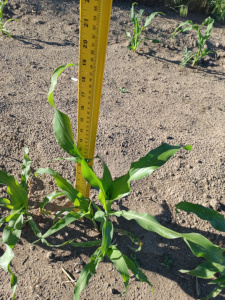
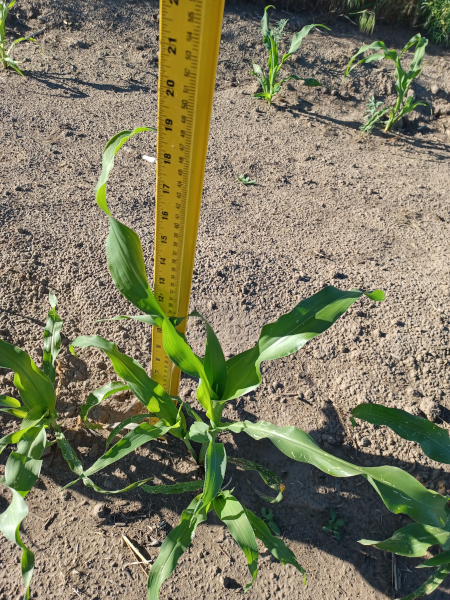
Hopi White Corn / Fast Growing / Tallest
|
Hopi White (July 9th Update)
The Hopi White which is planted in part of 2023 Field 2 is doing the best and in some areas canopy cover is slightly better than that of Wikti, about 75% in some areas. Emergence wasn't perfect and those planted by drilling with an augur did much better initially than those row-planted with the middle buster. Last year's patch of Hopi White was hand watered while this year's are not being watered, they are bigger, show little heat stress, and are tasseling. Some of these were from saved seeds and some were purchased seeds and plants in the saved seed area are bigger than the plants in the purchased seed area. My opinion of Hopi White has changed for the better (my current favorite) but we have to wait and determine the final yield per plant.
Location Location Location
The north half of Field 2 (Hopi White this year) has performed well 2 years in a row and as my seed count increases I'll test plant more areas (trial and error).
Hopi White (August 20th Update)
The Hopi White did very well until the 100°F plus days in July and first part of August. Hopi White forms a clump with tillers almost as large as the main stalk and can have several ears per stalk. Grasshoppers are not as bad this year but they are eating the silk, and I hope this won't be a problem since unpollinated silk should continue to elongate until pollinated. Some clumps have as many as 5 ears. Some of the augur drilled corn on the high parts between rows did well initially but then dried prematurely while some planted in the furrow stayed green longer. My conclusions are that this is a good area with some in ground moisture and, in contrast to previous years observations, increased planting depth does seem to increase access to water. Another explanation might be that the high part of a furrow planting has 3 sides exposed to air increasing evaporation, but some of the augur drilled which dried prematurely are not furrowed. By Aug 26th many of the plants seem to be drying with a few outliers. Frequently the stalks at the ends of the rows (less crowded) seem to stay green longer than those within the rows. Increased spacing between plants may have benefits (less competition for nutrients, water, and light) that outweigh the benefits of faster canopy closure (reduced evaporation). This area does not seem to be performing as well this year (2024) as in 2023 possibly because we had little snow accumulation the preceding (2023/2024) winter.
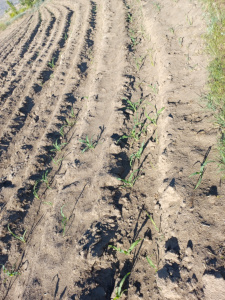
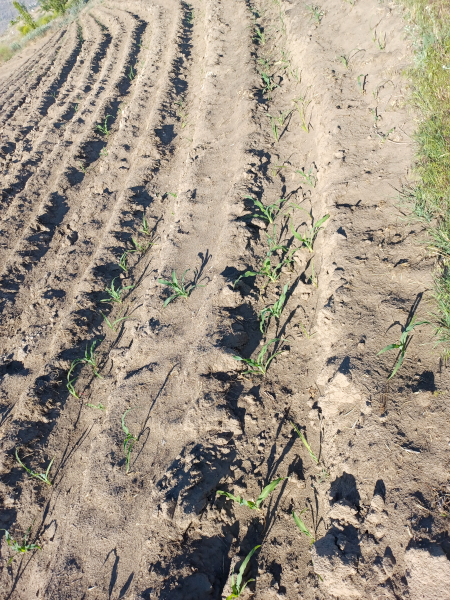
Hopi Pink Corn
|

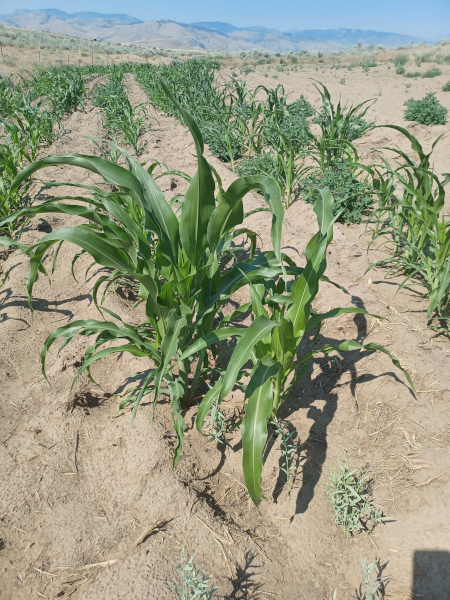
Hopi Pink Corn / Tasseling Jul 9th
|
Hopi Pink Corn from 2023 plus new Hopi Pink (total 2600 seeds) were each soaked and planted in separate areas of the same field by trench method and augur 300 feet south of the Hopi White field (2023 Field 2). The 2023 Hopi Pink were white with varying degrees of pink/red while the new seeds were a uniform darker "rose" color. Hopi Pink seeds from 2023 with more intense red coloration were grouped together. This area is next to our south fence,is the lowest on the the property, has deep sandy loam, and has patches of weeds that grow higher and stay greener indicating the deep loam may cover areas with underground soil seepage. We initially planned to plant all of the Hopi Pink but decided to reserve some for 2025 and only 40% of the prepared area was planted. To test the effect of contour plowing on moisture accumulation trenches were plowed roughly level in an east-west direction. An augur was used to drill planting holes 6-10 inches deep in a zig-zag pattern at the bottom and in between trenches on the high parts. Initially holes were backfilled but the trenches were not. Seedling emergence was spotty and about the same as for Hopi White. This area is the lowest on the property and June 16th (a month after the last expected frost date) we recorded 34°F and had frost on the windshield at 5:30 am. Much of the Hopi Pink outer leaves were damaged. The Smoik Hu:n 600' away in a flat area also had some freeze damage. The growth and appearance of Hopi Pink is very similar to Hopi White and plants are less than 5 feet tall. These plants make many tillers and a single seed results in a clump.
Hopi Pink (July 9th Update)
The Hopi Pink has recovered from the freeze but are showing signs of heat and water stress. Except the bottom 2 rows these plants are doing well, are tasseling, and are just slightly shorter than the Hopi White. The plants at the very bottom are dying from lack of moisture which is consistent with previous experiments where lower areas fared poorly. This is not far from our septic drain field which has 8ft or more of dry silt compared to a thinner layer of loam over a moist compacted layer of sand and gravel. I would think sand and gravel have high permeability making it drier but after digging 3-4' deep I found the the loam covered sand/gravel areas have moisture while the lower spots with "deep silt" are dry. Silt is notoriously hydrophobic and these areas don't absorb water as well and/or the water migrates deeper more quickly, not sure. I once dug out burdock near the irrigated trees and the deeper I went (in silt) the drier the soil but when laying pipe in a higher area with more rocks there was compact moist sand 4' down.
Planting at the bottom was a mistake but the areas 5' verticially higher than the lowest point in this field have some degree of moisture and may rival Field 2.
Hopi Pink (August 20th Update)
The bottom rows have continued to deteriorate but plants in rows above have done very well. Growth is similar to the Hopi White and again as many as 5 ears per clump. We had backfilled some of the trenches by kicking in the dirt when the plants were about 3' tall and they seem to have dried less than the Hopi White. This area is next to the old garden where we had the first Hopi Blue ears produced in 2022, and is a 2nd good area for corn. Conclusions are that this is another good area, Hopi Pink is very productive, planting deeper at the bottom of a trench increases moisture available to plants, backfilling/hilling around maturing corn stalks reduces evaporation, and planting in a zig-zag pattern makes hilling operations more difficult.
Hopi Pink (August 26th Update)
Quite a few of these plants are drying. Backfilling looks like it may have helped some. This is the best field (second to Hopi White) with a decent percentage of stalks still green and about 40% producing multiple ears (as many as 6 per plant).
The Intermission
By mid May weather predicitions were for a very hot dry summer, windspeeds were generally high during the days, and we took a week to decide if we should continue planting or save seeds for 2025. I had soaked 2500 Kikam Hu:n seeds and had 2 more prepared fields, one west of the Smoik Hu:n and another 1½ acres spanning the width of property 400 feet north of any other fields.
Kikam Hu:n (Pima 60 Day Corn)
The Kikam Hu:n seeds were soaked during "the intermission", sprouted, and were 2-4 inches high at the time of planting. We wanted to save this strain so selected 120 of these seedlings and planted them in an irrigated bed. Kikam Hu:n is a short fast maturing corn with 80% soft flour and 20% flint kernels and can be harvested at the 60 days milk stage or when dry.
Kikam Hu:n (Update August 20th 2024)
This corn did not mature any faster than any of the other varieties despite being fertilized and irrigated. The ears of this variety are generally long and skinny.
Hopi Blue
Between May 26th and June 6th we planted 1½ acres of Hopi Blue corn. The area was plowed and trenched roughly on contour in areas where the grass was taller and the soil had higher levels of moisture. In this area rain is usually light and doesn't last long so contours will help trap snow and increase water absorption during spring thaw, but perfectly level berms aren't necessary. The soil in most areas was moist, dark, and clumpy after using the middle buster. Seeds from the best ears of Hopi Blue from 2023 were selected for planting, and 50 Hopi Blue seeds from an outside source were mixed in to maintain population diversity and reduce the chance of inbreeding depression. A few ears from 2023 had a mixture of white and blue kernels or had maroon/blue chinmarked kernels and these were saved but not planted with regular blue. Seeds were soaked overnight, allowed to rest for 9 hours, rinsed, and planted using trench, hand seed, and cover using the rebar harrow method. Four rows were planted first, followed by four rows 2 days later, and this was continued until the field was planted, except for the northwest ¼ acre which appeared dry. Seedling emergence was excellent with the first 4 rows emerging on June 7th followed by the next 4 rows on June 9th and then a few seedlings emerged in rows 9-17 on June 11th. The results from this area should be interesting since there is a small slope south of the field which drains north to the field and spring snow melt collects on the driveway at the northeast corner of this field. Hopi Blue is a delicious soft flour corn and even when dry can be chewed raw with a starchy slightly sweet after-taste. Hopi Blue is 5-7' tall and usually makes 2 tillers, not quite as many tillers as Wikti. Smoik Hu:n, Hopi Pink, and Hopi White.
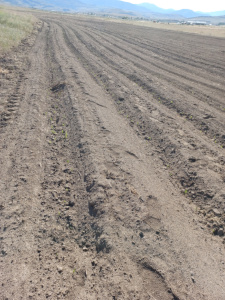
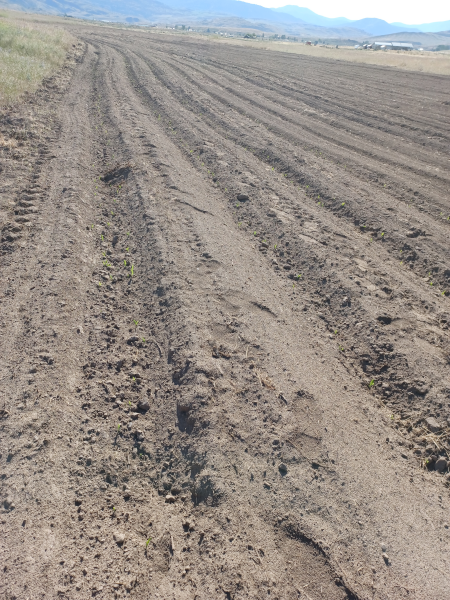
Hopi Blue Corn / North Field
|
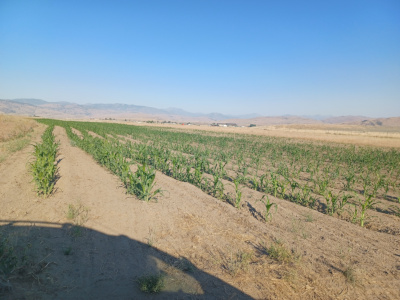
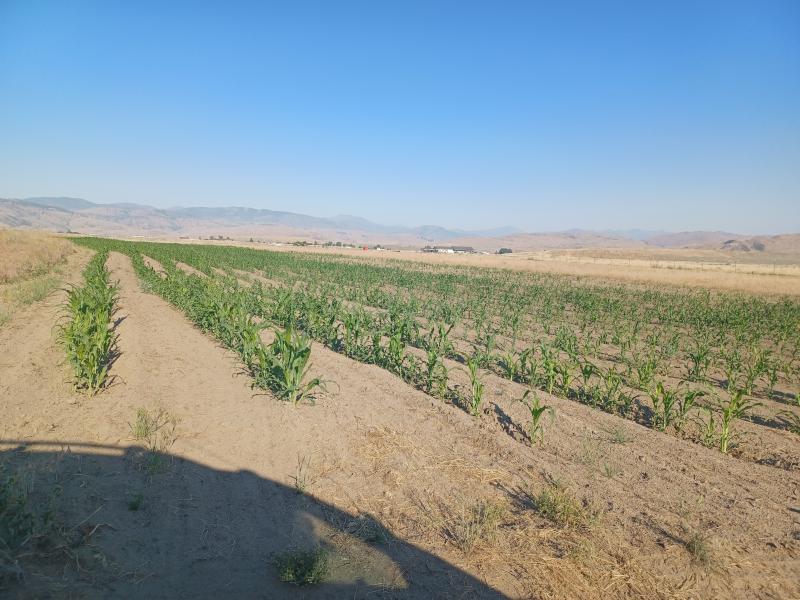
Hopi Blue Corn / Jul 10 2024
|
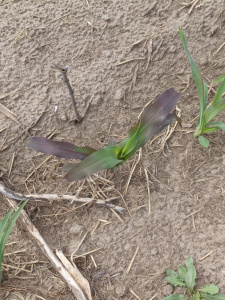
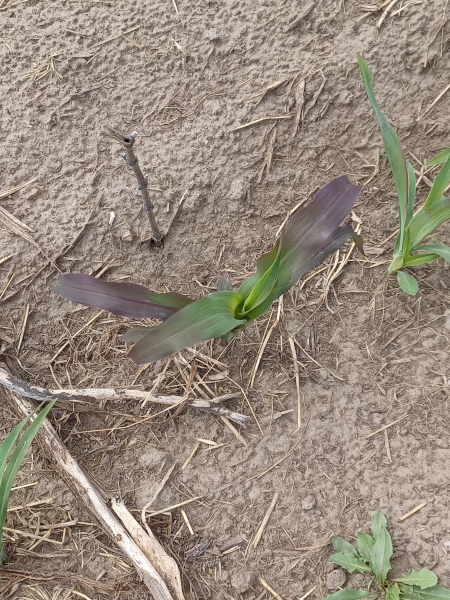
Hopi Blue Corn / Red Leafed Plant
|
Hopi Blue Red Leafed Plant
In 2023 we had one Hopi Blue corn plant that was completely purple/maroon colored in Field 1 that did better than average and produced a medium sized ear while many others had none or ears with only 2-3 kernels. Plants that were partially purple colored seemed to do better than average so the seeds from red-stalked corn were saved separately. A feral cat got into the storage area and spilled 2 containers of seeds, including the pure red-leafed seeds. Spilled seeds were sorted based on slightly darker purple kernel coloration and saved. The seeds from the Hopi Blue (pure red plant) were planted at one end of the north/front field and surrounded by seeds of reddish plants which were again surrounded by seeds of regular Hopi Blue corn. I found one mostly green seedling with barely colored leaf tips that quickly became darker and a few days later more (not many) in the patch started turning purple. Purple color is caused by accumuation of anthocyanin pigments and can be caused by genetic factors which do not affect productivity. Purple color can be caused by cold weather or lack of phosphate in seedlings or by poor kernel development near maturity which causes an accumulation of unused sugars. These plants are purple at all stages from seedling to maturity and the red plant grew among green plants indicating the coloration is likely the result of genetic factors which doesn't negatively affect productivity.
Hopi Blue (July 9th Update)
I believe thinning is a necessary operation as in 2023 I saw areas that were overplanted and not thinned that did not grow well or make ears. We went through on hands and knees to thin the corn, 2 rows at a time, on the left and on the right for each pass. My son and I did most of this together so we did 60-80% of 4 rows in the evening after work on some days. It is always preferable to remove the weaker plants. The aim was to thin the plants 8-12 inches apart but leave 2 together if there were no plants 18 inches on either side. Some area were thinned much less than this (left 4 inches apart in some areas) and others were not thinned at all. If plants are too close together, thinning will disturb the roots of nearby plants doing more damage than good. Breaking plants off the above soil line does not always work as they easily grow back from the middle. If there are 3 plants with 2 plants very close, it is better to remove the two together and leave the third that is farther away undisturbed. But, what if the 3rd one is weaker? When thinning it is important to have the right balance between speed at quality. Don't over think it, leave both together and remove the third or pull 'em both out, and most importantly "just keep swimming!"
Most of the Hopi Blue is over 6" high some more than 1' high. As seen as a whole it is clear from soil color and leaf color during the later parts of the day there are areas with less moisture. Interestingly plants in the slightly higher north-facing slope (south long side of the field) appear to be doing better supporting previous experiments on the property where low areas have less available moisture. Silt feels like flour when dry and we have many pockets of "moon dust" that feels like flour and both sand and silt are known to be hydrophobic. Packed silt is probably repelling water and contour tilling may be beneficial by increasing water accumulation in these areas.
In some areas, the rows were not backfilled enough and corn plants are falling over and dying. Future planting should be adjusted to drag with the rebar harrow at least 3 times and possibly with the tines down rather than upside down. When the soil is moist the middle buster makes clods with gaps between the clods and the rows are not filled in properly with only 1 pass. Some of the young corn plants are not properly supported and I recommend now 3 passes with tines down on the last pass followed by a cultipacker.
Corn spacing is another issue. To trench, seed, and backfill a double row in a single operation would be ideal but the old 27hp Yanmar tractor I am using can just pull a single middle buster without a seeder. The next best option may be to use a single middle buster for a first pass and in a second pass use a modified seeder with coulters to seed at the bottom of the trench.
Hopi Blue (August 20th Update)
The Hopi Blue fared poorly in the north field when temperatures were 90-110°F most of July and first part of August. It has been fairly windy with a light sprinkle once or twice, just enough to keep the dust down for 30 minutes. Much of the field has turn a dry papery green with only few sections making ears. Good areas and ear production does not seem to correlate with plant spacing but more of a general area (eg all plants in one area do either well or poorly with few outliers). The best area seems to be on the south side of the middle, which is slightly higher and sloping north. There are occaisional outliers in poor areas which may have been planted deeper or may have a better root structure. Another observation for both 2023 and 2024 is that plants that grow quickly and vigorously seem to be the first to die when hot weather arrives. Most of this area is too dry to grow corn and I am expecting less than 5-10% of the field to have ears.
Selecting for improved root structure may be the most effective way to genetically increase yield the absence of irrigation (without making hybrids to import traits like stay green).

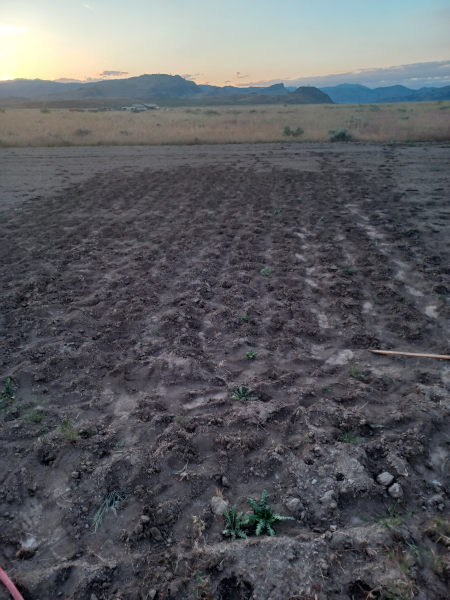
Concha White Corn / Planted June 9th
|
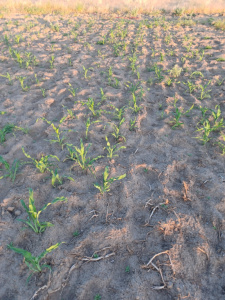
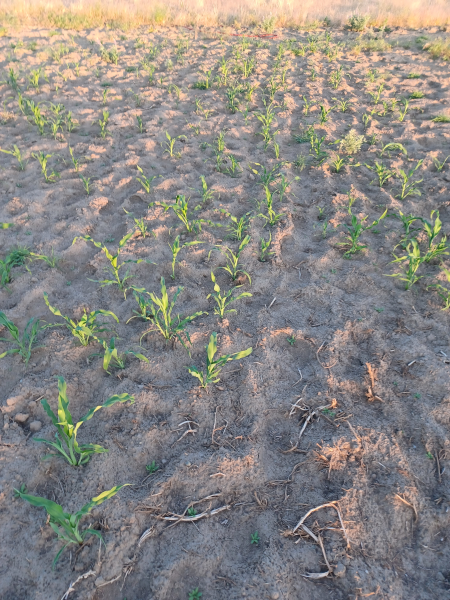
Concha White Corn / Jul 9th 2024
|
In 2023 more than half of the Concha White survived without irrigation, while under the same conditions, the Pima 60 Day Corn and other Hopi varieties tested mostly died (though none produced kernels). Planting the field west of the Smoik Hu:n was postponed because it was windy and the soil appeared very dry on top. In early June we tested several areas with an augur and soil moisture appeared relatively good (soil was darker and clumpier a few inches down). Seeds were soaked on Friday the 7th and planted on the 9th between 6 and 8 am. Four hundred Concha White (with 200 kept in reserve) were combined with less than 100 selected white kernels from the 2023 Hopi White, Hopi Pink, and Hopi Blue batches and planted in north-south rows using the augur zig-zag method. Zig-zag rows were spaced 1½-2 feet apart to test the effect of closer planting and early canopy closure on soil evaporation and growth. To give the seeds a head start and to compensate for reduced soil moisture the holes were sparingly watered after seed placement and then backfilled.
Concha White x Other Selected White Kernels (Update August 20th)
Emergence was better than I though inititally and part of this patch is doing well and making ears. These were planted close together and augur drilled with no furrows. An single initial application of water after planting seems beneficial and warrants further testing. The patch is small and the area seems like it might be the 3rd best for growing corn. Since several types of corn were planted it is hard to determine if a certain variety is doing better or the variation is the result of location. The corn at the north end of this patch is doing best. Once I have enough seeds I'd like to plant larger areas evenly to map out and mark which areas are best. The corn from this patch will be a White Concha-Hopi hybrid and will be selected further for improved yeild in absence of irrigation).
Planting Spacing (Update Sep 2)
The root system of Hopi Corn extends horizontally much more than expected compared to other similar sized crop plants. I went back and looked at my observations and comments since 2022 and I am kicking myself for not learning this sooner even though in 2022 the Hopi Corn did not do well when closely planted (even with irrigation.
Before planting in 2023, I did some calculations of how much ground area I thought should be given for each plant. Before planting in 2024 I though spacing might be less important than faster canopy closure, but this was wrong. In fact everything the Hopi do when planting corn seems to have a scientific basis. Spacing plants far apart reduces competition for ground moisture, making a hole and filling completely reduces evaporation compared to furrow planting, planting deeply increases access to available moisture, and planting multiple kernels per hole ensures at least some stalks emerge when planted deeply.
In 2023 we did not till in fertilizer before planting but corrected that for all fields planted in 2024. Results are significantly better for all fields, eg some fields are doing poorly but plants that are doing well are making more ears and have more kernels than previously. Plants at the ends of rows and on outside rows do better than plants in the middle. This year the Concha White was planted close together to test the effect of canopy closure. This patch looks roughly like a green square with dried plants in the middle indicating that plants are competiting for ground water and the ones in the middle need more space to produce in the absence of irrigation. While planting closer together results in faster canopy closure and less evaporation, this reduced evaporation is not as important increasing plant spacing to decrease competition for ground water.
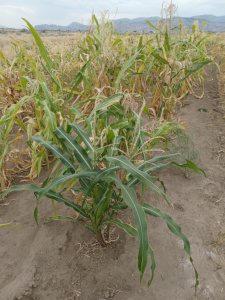
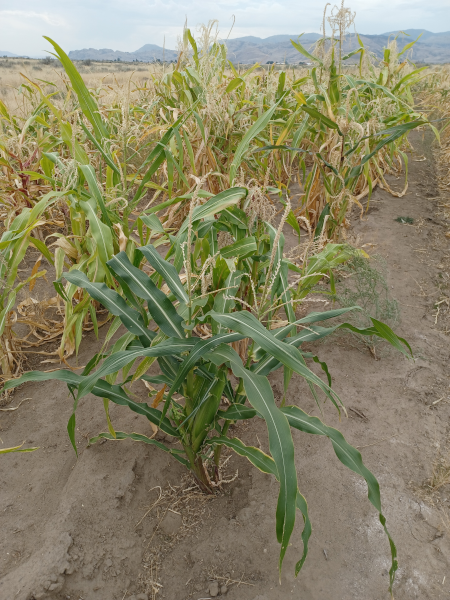
Hopi White / End Of Row 1
|
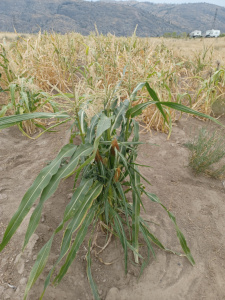
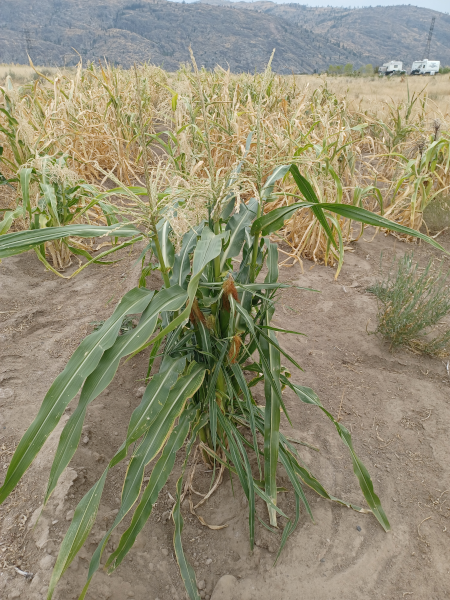
Hopi White / End Of Row 2
|
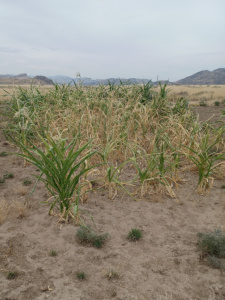

Concha White / Square Dry In Middle
|
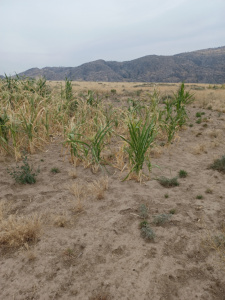
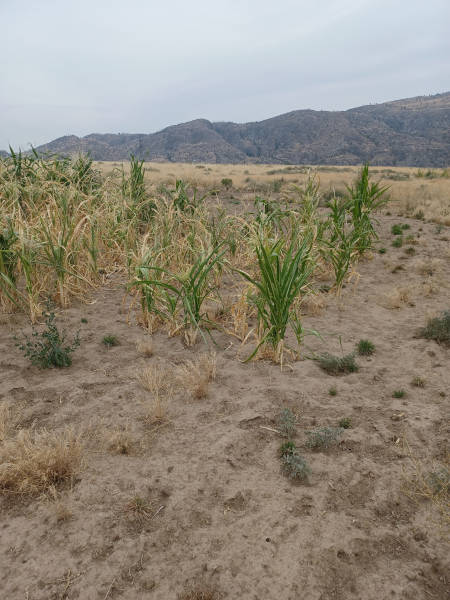
Concha White / Green South Edge
|
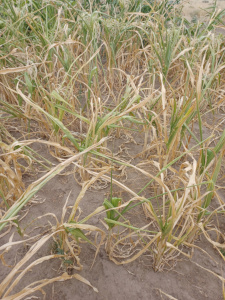
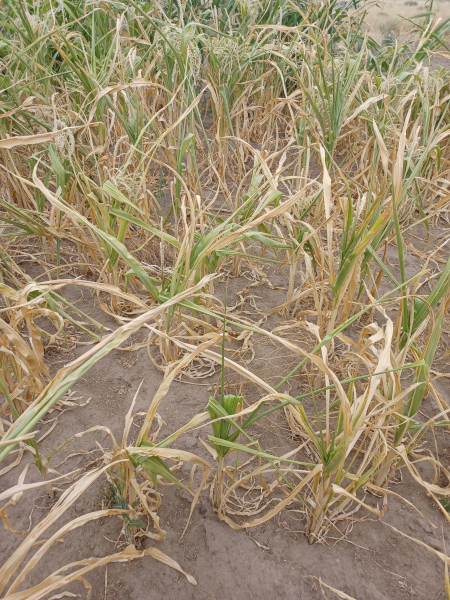
Dry Middle / Green North Edge Behind
|
Checking online various sources say the Hopi plant in blocks 5-7 paces apart, Akhima says "4 steps in between", another source says in blocks 4.9-5.7 feet apart, and Collins has pictures of hills he says are 20 feet apart. In some videos by Michael Kotutwa Johnson the hills look to be 7-10 feet apart and he also uses a tractor to plant in 6 foot rows. Hill spacing could then be anywhere between 25 and 400 sq. feet per hill. Hills are thinned to 4-7 plants per clump. If hills were 10 feet apart with 4 plants per hill that is 25 square feet per plant. If hills were 20 feet apart with 7 plants per hill that is 57 sq ft per plant. Most Hopi varieties I have tried develop multiple stalks from tillers and can produce up to 6 ears per plant so 4-7 plants per hill may not be necessary. Conversely more plants per hill may inhibit tiller formation. Yield estimates done per hill may be easier to calculate independent of the number of plants per hill. Each corn ear can have between 0.25 and 0.8 lbs of kernels. If a hill produces 4 ears each or about 2 lbs per hill with hills 6 feet apart this would yield 1210 hills * 2 lbs or 2420 lbs / 43 bushels per acre. This seems to be a reasonable estimate since dryland wheat makes 42 bushels per acre in my region. The next experiment will be to increase spacing to least 20 square feet per plant to see if this increases yield. I good middle ground might be 3-5 plants in hills 8-9 feet apart. If row planting a 5' x 5' spacing may yield better results than the 1' x 4' spacing used in 2024.
Yields are understandably less than expected compared to an in a irrigated field. One thing I noticed when doing this research again was the phrase that Hopi farming relies on "labor intensive" methods. I have been unsuccessfully trying to find a way to streamline the process of growing corn without irrigation but this may not be possible without developing specialized equipment for deep planting.
Fertlizer Adjustment For Reduced Plant Density
The roots of corn plant extend up to 10 feet around each hill to reach water and nutrients and broadcast fertlizer recommendations need to be adjusted to compensate for plant density and removal of nutrients by the crop. Normal corn density is 30000 plants per acre and a yield of 177 bushels per acre. If we assume 5 plants every 49-81 sq ft that is 2688-4444 plants per acre or about 10 times lower plant density. Assuming dryland corn planted with correct spacing can make double the 42 bushels for wheat, 177 bushels / (42*2) bushels = 2 which means fertlizer should be reduced to 1/2 (based on yield) and up to 1/10 (based plant density) of the normal rate.
Weather Comparison
According to Michael Kotutwa Johnson the Hopi have no rain from April to the end of July so looked up some numbers. Monthly totals can be a little misleading since in Okanogan the table shows June and September has having about 1 inch of rain but last half of June and first half of September are usually dry. This year was unusual and we had 0.5 inches of rain on August 20th. I have not compared with temperature averages but the dry periods are comparable but shifted such that the dry period in Arizona is earlier. The bulk of precipitation in Okanogan is in winter months in the form of snow. In Arizona the Hopi plant corn in mid April when soil the in Okanogan is still too cold for corn to germinate. I have successfully planted in late April and mid May but the time of emergence of the April planted corn was delayed and similar to the May planted corn.
| Arizona | Okanogan | |||
| January | 0.4 | 2.1 | ||
| February | 0.4 | 0.4 | ||
| March | 0.9 | 0.5 | ||
| April | 0.2 | dry | 0.6 | |
| May | 0.0 | dry | 0.8 | |
| June | 0.3 | dry | 0.8 | partly dry |
| July | 0.7 | 0.2 | dry | |
| August | 1.0 | 0.3 | dry | |
| September | 0.7 | 1.1 | partly dry | |
| October | 0.6 | 1.0 | ||
| November | 0.5 | 1.5 | ||
| December | 0.4 | 1.4 | ||
See our Winter Wheat Planting 2023 Here